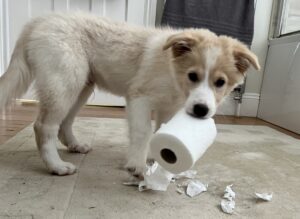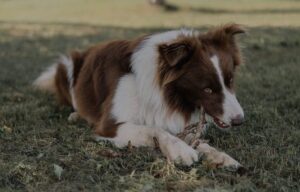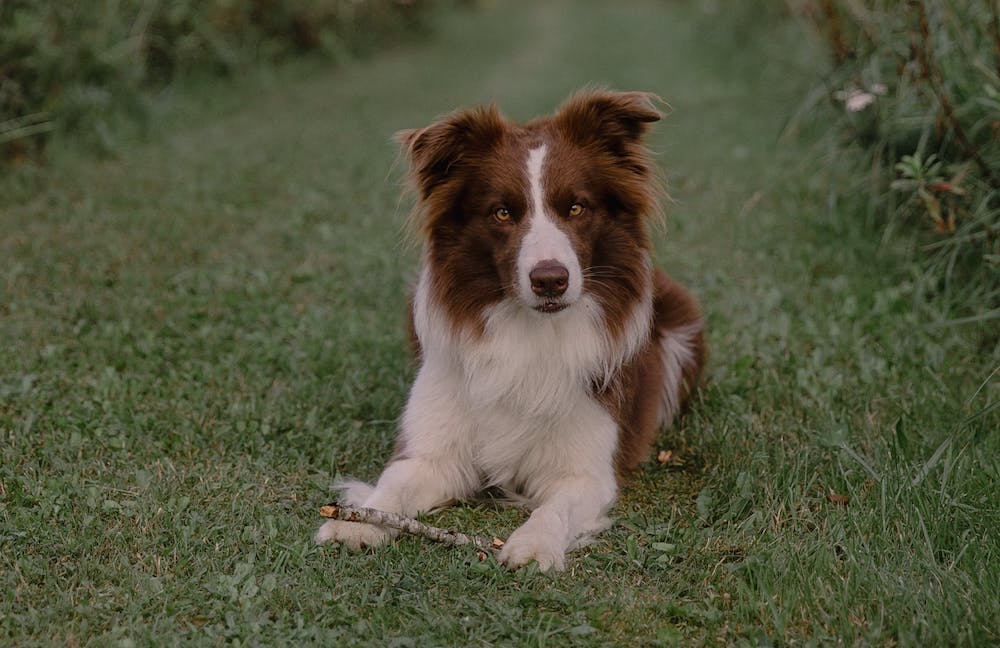One of the biggest causes of border collie guarding behaviour or running off with stolen items in collie puppies is when owners worry too much about what their puppies are picking up. There is a lot of information and owner anecdotes online that can scare us into thinking that all sorts of things could be lethal for our puppies. The reality is that, in most cases, puppies are just exploring things with their mouths and are unlikely to eat them. Over-reacting by trying to snatch things off puppies, or force them out of their mouths can make the problem much worse over the longer term.

- Socks
- Leaves
- Tissues or loo rolls
- Sticks
- Stones
- Acorns
- Hair bobbles
- Food packaging
- Poo (including their own)
Many others!

- It’s fun: Grabbing items and running off with them is fun and gets everyone involved in a great fast-moving chase game.
- These items must be extremely high value: Owners grabbing puppies and taking the items away make puppies learn that the items must be very high value if we want them that badly too.
- Humans can be scary when we grab items: When owners try and force puppies’ mouths open and tell them off for picking up the items, puppies learn that it’s better to run away with the item than to stay and risk being shouted at or having their mouths grabbed and unpleasantly forced open, so fear of the owner starts to cause running away with items.
- Picking up items your owner doesn’t want you to have can earn you treats: whilst this is a really common way of getting puppies to give up items willingly, it doesn’t take long before our very clever border collies learn that one of the quickest way to get treats is to grab something they shouldn’t have!
One of the most worrying outcomes of trying to get stolen items from dogs is that they can actually end up swallowing the item to prevent you from getting it. Depending on what the item is, this can be really dangerous.
Choose your battles

If the item is something that could hurt him or is valuable or precious to you, then you can use the following methods to retrieve the items without any of the above issues.
Manage the environment
We want our puppies to be right so that we can praise them, rather than be following them round telling them off for everything they are doing wrong. Therefore, it’s important to manage the environment. Don’t leave anything that could be dangerous or that your puppy could wreck, within his reach. Puppies are going to be into everything – it’s how they learn, so if you don’t want him to steal socks or hair bobbles, don’t leave them lying about where he can reach them. If you don’t want him to eat his own poo, ensure that the garden is poo-free and clean it up as soon as he has done it. If you don’t want him to eat leaves on walks, avoid taking him under trees.
Techniques for retrieving items from puppies
So, what DO we do when our puppies get hold of something we don’t want them to have?
- Try not to react – stay calm, don’t make any sudden movements and behave as though nothing of interest has happened. Just keep an eye on the puppy and make sure that he’s not actually eating the stone or swallowing the sock. Often puppies will just lose interest in the item at this stage and drop it again.
- If stage one doesn’t work, try picking up something nearby that the puppy CAN have, but don’t interact directly with the puppy (to avoid the puppy learning that grabbing the item gets attention). Behave as though you’re really interested in the new item, hold it, pretend to eat or sniff it, then pull it along the floor near the puppy until they have lost interest in the item that they have, and run over to see what you are playing with. However, don’t make the mistake most people then make when using this method. As soon as the puppy is interested in the item you are trying to transfer him to, DON’T then go and grab the “contraband” item in full sight of your puppy. When puppies see this happening, they very quickly learn not to be fooled into giving up their item next time!
- If stage two doesn’t work, or if your dog has already become suspicious of this subterfuge, then Chirag Patel’s counting game is a great way of getting dogs to move away from items they shouldn’t have without appearing to show interest in the dog or give him any direct attention. If you don’t have treats on you, run and fetch them. High value treats such as chopped cheese, chicken or sausage are all good but if you don’t have these pre-prepared and don’t have any treats handy, just a piece of bread, broken into tiny pieces, will work. Move a little way away from the dog, but where he can clearly see you, and start counting out treats as you put them on the floor. So say one, put a treat down, two put a treat next to it, three, add another treat to the pile, and so on. Keep going until the dog comes over to see what you’re doing. As soon as he comes over, move a few feet away, in the direction opposite to where his stolen item is, and start counting again. When he comes over, move again. Do this 4 or 5 times, then distract him with another game and take him into another room, or into the house if you were outside. As in point 2, don’t grab or pick up the item when the dog is looking – move to a completely different area and go back and pick it up later.
- Sometimes, if the items that your puppy grabs are revolting things on walks or in the garden, such as his own poo, or fox poo, try to ignore it to start with, or use the above techniques to get him away from it. Dogs aren’t going to become seriously ill from eating poo, and ignoring him can help to ensure that your reaction doesn’t lead to it becoming a habit.
- However, if it starts to become a habit, and the above methods don’t work, then turn it into a game: encourage him to find his poos, then praise him and give him treats as soon as he finds one. He will find the treats more palatable than his poo, so will hopefully find the poo and wait for his treats without grabbing and eating it.
- I’ve never tried this technique, but it could theoretically work. It involves leaving so many items that your dog loves to grab around that he becomes bored with them. So, for instance, if your dog loves to steal socks, leave lots and lots of socks lying all over the place, show no interest in him when he picks them up, and he will soon start to lose interest.
- Knocking things off the table game. This game, adapted from an idea by behaviourist Danielle Beck, is a set up that is great for helping dogs that steal things we drop from tables, worktops or other surfaces, and can help with dogs that steal items in other situations as well. Sit at a table with items that won’t hurt your dog, such as loo rolls, twigs, old children’s toys, anything that is safe for your dog and that you don’t mind if he chews. Knock one of the items off the table and completely ignore him when he grabs it. Knock another one off and ignore. Then another one. Watch your dog and every time he makes eye contact with you, use his marker word or a clicker and drop a treat on the floor instead. As soon as he makes eye contact again, use his marker word or a clicker, and drop another treat, and repeat. Every so often, drop an item, then wait for eye contact again and drop a treat. Over a relatively short amount of time, your dog is likely to ignore the items to focus on you and wait for his treats.
Examples of resource guarding of items
Case 1

Case 2

If you have any issues with border collie guarding behaviour or need more advice about managing puppies and stolen items, please get in touch and I’ll be happy to help.


My Onion used to bring me a gift every morning when he was a puppy, sometimes something I’d prefer he didn’t have! He mainly chewed his toys, though, and unfortunately often swallowed the bits. He used to have a ‘road runner’ plastic chicken, which gradually disappeared. I was quite embarrassed when he decided to poop close to a group of elderly gentleman and they looked down horrified as a bright yellow chicken head appeared and lay there looking up at them.
That’s so funny!!!